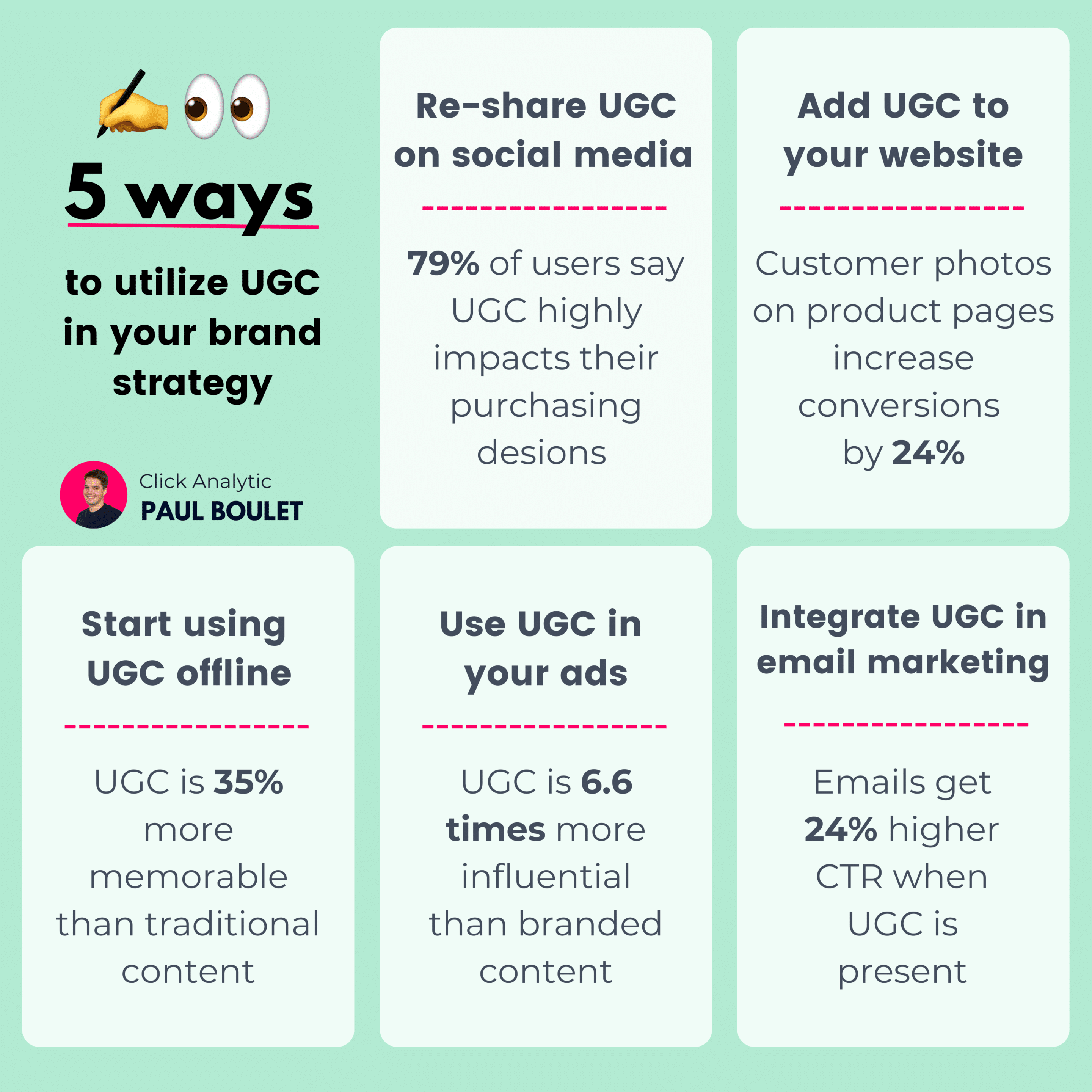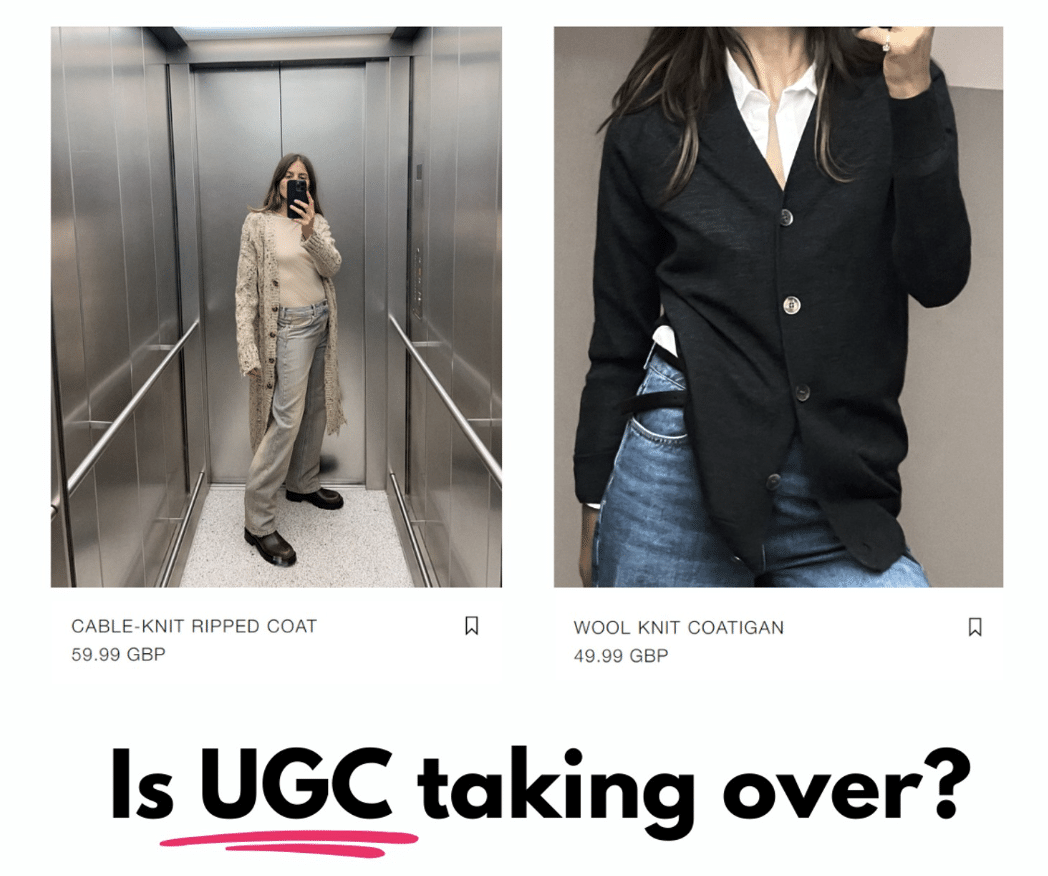Influencer marketing benefits and disadvantages
Curious about unlocking the key influencer marketing benefits for your business?
You’re not alone. Influencer marketing benefits have transformed top brands with impressive results:
-> Marc Jacobs grew its social media presence by 500% in just three months through influencer marketing benefits.
->Poléne doubled its sales within a year, thanks to the viral social media buzz created by influencers.
->Daniel Wellington skyrocketed to $230M in revenue after investing a mere $15K in influencer partnerships.
Despite these success stories, many entrepreneurs are still unsure about how to leverage influencer marketing effectively. The truth is, the benefits of influencer marketing are clear—brands that use it can see an ROI of up to 11x. In fact, one in four marketers says that influencer marketing is second only to short-form video content like Reels and TikToks in driving results.
Sounds promising, right? But how do you know if influencer marketing will bring similar benefits to your brand?
This guide will walk you through everything you need to know about the benefits and disadvantages of influencer marketing, helping you decide if it’s the right strategy to fuel your brand’s growth. By the end, you’ll have all the essential insights to get started and harness the power of influencer marketing for your business.
-> What influencer marketing is
-> 12 benefits of influencer marketing
-> 6 disadvantages of influencer marketing
-> 6 types of influencer partnerships
-> Can your business use influencer marketing?
-> Conclusion
-> Q&A
🎁 Also, grab some Free Gift on your way to master Influencer marketing 🎁
Ready? Let’s dive in! 👇
What influencer marketing is
To fully grasp influencer marketing benefits, we need to first understand who influencers are.
Alerte au spoiler : influencers are individuals who have built an audience or community around themselves and have the power to influence that group.
This is precisely why the benefits of influencer marketing stand out compared to other channels like ads or TV commercials. Influencers, with their strong personal brands and authentic content, have built significant authority and trust within their communities, making them incredibly effective in driving results.
📊 Mind-blowing Stat: 92% of consumers trust influencers more than traditional ads, highlighting one of the biggest influencer marketing benefits—the trust factor.
Let me hit you with an interesting example from centuries ago. Yes, you read that right—influencer marketing benefits have been around long before social media.
Back in 1760, Queen Charlotte of England fell in love with Josiah Wedgwood’s tea sets and spread the word about them. As a result, other royal families were influenced, and over 200 years later, the Wedgwood brand is still thriving. This historical example shows how influencer marketing benefits have always been powerful, even without social media.
But now? You don’t need to be royalty to experience the benefits of influencer marketing. Social media has democratized influence, allowing anyone to become an influencer.
Today, influencers come in various forms, but I’d break them down into four main categories:
1️⃣ Celebrities (athletes, artists, models, actors, etc.)
2️⃣ Micro-influencers (people with smaller but highly engaged audiences)
3️⃣ Industry experts and thought leaders
4️⃣ Bloggers and content creators
These diverse categories all contribute to the wide-reaching avantages du marketing d'influence, offering different ways to connect with and influence specific audiences.
But what exactly is influencer marketing?
Influencer marketing is a rapidly growing channel that involves collaborating with social media influencers, content creators, bloggers, thought leaders, and celebrities to drive sales, boost conversions, or build brand visibility.
📊 In fact, 75% of brands are continually investing in influencer marketing, and for good reason—it works!
Here’s a standout example:
In 2011, the founder of Daniel Wellington chose to invest just $15K in influencer marketing instead of spreading the budget across multiple channels. The result? By 2017, Daniel Wellington became the fastest-growing private company in Europe, generating $230M in revenue, selling over 6 million watches, and becoming the most mentioned brand in Instagram-sponsored posts.
This success story highlights the pros of influencer marketing: impressive ROI, rapid brand growth, and increased visibility.
But what about the cons of influencer marketing?
While influencer partnerships can skyrocket revenue, there are potential downsides. Influencers can be expensive to work with, especially if they have large followings. Additionally, not all influencers may align perfectly with your brand, and measuring long-term success can be tricky.
Ready to dive deeper into how to navigate the les avantages et les inconvénients du marketing d'influence for your business?
Follow me as I guide you through the best approaches to maximize results.
12 Influencer Marketing Benefits
Ready to know more about the Influencer marketing Benefits ?
Influencer marketing isn’t just another trend—it’s a game-changer for brands of all sizes.
Let’s dive into some key benefits:
1. It’s Trackable
TV and print ads might reach millions, but here’s the catch—you can’t track the customer journey or pinpoint when someone turns into a lead.
That’s the problem with traditional marketing channels: you’re left guessing.
Influencer marketing flips the script. It’s completely trackable.
With promo codes, UTM links, and affiliate programs, you can measure every click, sale, and conversion. You’ll know exactly what’s working and, best of all, you can adjust your campaigns in real time for maximum impact.
2. It Builds Trust
People trust people—not ads.
Influencers have built a strong rapport with their audiences, and many are true experts in their fields. When they recommend a product, their followers listen.
63% of shoppers say they’re more likely to buy a product if it’s recommended to them by a social media influencer they trust.
Influencer marketing delivers higher trust than traditional marketing.
3. It Helps You Understand Your Audience
Collaborating with influencers gives you a backstage pass to your audience’s behavior.
By analyzing influencer metrics, you can see what kind of content your target market is engaging with and why.
That’s pure gold for crafting future strategies.
4. It’s a Precise Targeting
PR campaigns give you a massive reach. The problem? You don’t really know who you’re reaching.
Unlike other methods, which might be hit or miss, influencer marketing is laser-focused.
You know exactly who you’re reaching—the influencer’s specific audience that you can research from top to bottom. That means better results and less wasted effort.
5. It Boosts Brand Authority
In a crowded market, influencers help distinguish your brand. Their credibility transfers to your products, positioning your brand as trustworthy and reliable.
A credible influencer can elevate your brand above the noise and make you stand out as a leader in your industry.
6. It Improves SEO
Influencers don’t just drive sales—they boost your brand’s online presence too.
High-quality backlinks from influencers’ content help improve your site’s SEO, while social SEO grows your presence across platforms.
7. It’s Affordable
Influencer marketing delivers up to 11x ROI. And the best part? It works for any budget.
If working with big celebrities or macro-influencers isn’t possible, you can tailor campaigns to fit your goals. In fact, micro-influencers often deliver better results because of their highly engaged audiences.
8. It Tackles Many Brand Challenges
Need to boost your brand’s visibility? Partner with macro-influencers or celebs who can reach millions with a single post.
Want to drive sales? Micro-influencers often have stronger engagement and trust with niche audiences, making them perfect for lead generation and conversions.
9. Influencers Add Value and Increase Conversion Rates
Gen Z doesn’t trust branded content—it’s a fact.
Instead, younger generations are influenced by recommendations on social media, not by professional photoshoots.
68% of Gen Zers say they prefer to learn about new products through influencers rather than directly from brands.
Interestingly, they value influencer recommendations more than those from friends and family.
Influencers add value to products by providing new insights and showcasing product usage, increasing conversion rates—5 times higher than traditional digital marketing.
According to Instagram, 87% of users said influencers inspired them to make a purchase.
Qu'est-ce que cela signifie ? Influencer content leads directly to buying decisions.
10. Influencers Build Social Proof
Influencer marketing is the new word of mouth.
Creators build social proof and awareness about your brand.
The main difference? It’s primarily done online.
11. Creators Build a Bank of Content
Creating content can be time-consuming, but influencers solve that problem by producing engaging posts you can repurpose across your other channels.
Just remember to negotiate content usage rights upfront!
12. Influencers Help You Reach the Desired Audience
Influencers have loyal followings within specific niches, so you can target exactly the right demographic or interest group.
Broader channels like TV or radio might cast a wide net, but influencers hit your bullseye.
By the way, with tools like Click Analytic, plateforme de recherche d'influenceurs, you can find the perfect influencer based on their audience’s demographics, location, language, and more.
Let’s be real—I could go on for hours about the benefits of influencer marketing. But you get the idea. It’s effective, affordable, and can work wonders for your brand.
Now, let’s talk about the other side—because nothing’s perfect, right?
6 Disadvantages of Influencer Marketing
Understanding the Disadvantages of Influencer Marketing
While marketing d'influence is highly effective, it comes with a few hurdles that brands should be aware of.
1. More Hands-On Process
Influencer marketing isn’t exactly a “set it and forget it” kind of strategy.
You’ll need to dedicate time to build a scalable program that takes your brand to the next level. It’s not just about picking influencers and hoping for the best—you’ll need to structure your campaigns to fit your budget and, more importantly, track and analyze the results of each one.
This will help you tweak briefs, refine key messaging, and optimize content for better performance every time.
💡 Conseil de pro : Track the performance of each creator’s campaign so you know what’s working and what to ditch.
2. Lack of Controls
One downside? You can’t control everything influencers post.
But here’s the trick: while influencers thrive on creative freedom, it’s essential to nail down key messaging and brand guidelines before signing any deal. This ensures that their content still aligns with your brand’s vision.
3. Cost Variation
Sadly, there’s no set pricing in the influencer world.
Rates fluctuate based on factors like follower count, engagement, and niche. This can make budgeting feel like guesswork sometimes, since you need to negotiate the price with each influencer individually.
4. Legal Considerations
Don’t sleep on the legal side.
Sponsored content has to be disclosed, and slipping up on ad transparency can land you in hot water.
Just ask influencer Grace Beverley, whose post about her own brand, Tala, was taken down by the ASA for not being tagged as an ad.
Yup—even when promoting your own business, the rules apply. So, make sure you’re ticking all the boxes to avoid any unwanted surprises.
5. Creator-Brand Mismatch
Choosing the wrong influencer? That’s like lighting your budget on fire. The influencer has to vibe with your brand and your audience, or it’s a complete miss.
Case in point: Kylie Jenner promoting the phone game “Travel Town” left people scratching their heads. Her audience is all about beauty, not mobile games. It just didn’t connect.
But finding the right fit doesn’t have to be a struggle — Click Analytic’s database of 250M+ micro and macro influencers can match you with the perfect partner in minutes, not hours.
6. Potential for Negative Publicity
An influencer’s personal controversy can become your brand’s problem real quick. Always do a background check to avoid any PR nightmares that could backfire on your brand.
Remember the Pepsi and Kendall Jenner fiasco in 2017? Pepsi tried to reference the Black Lives Matter movement, but using Kendall—a supermodel with her own controversies—completely missed the mark and caused major backlash. Don’t let that be you.
Now, let’s recap:
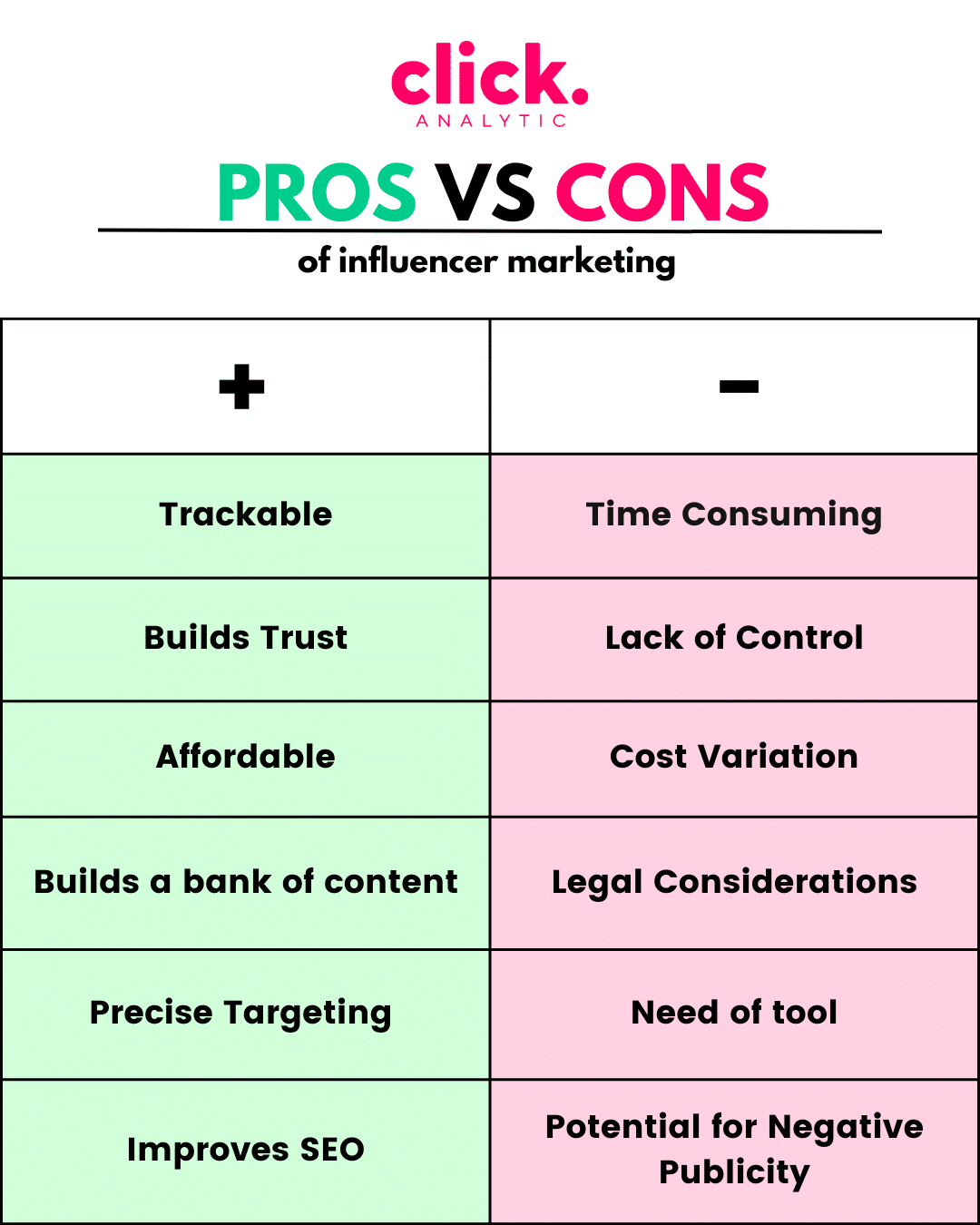
Maximizing Influencer Marketing Benefits for Your Brand
Your next question is likely: how do brands collaborate with influencers to unlock the full benefits of influencer marketingand skyrocket revenue?
The key lies in strategic partnerships that align with your brand’s values and target audience. By choosing the right influencers, your brand can experience the many influencer marketing benefits such as increased visibility, stronger customer trust, and higher conversion rates.
Stay with me as I walk you through the best approaches to harness these influencer marketing benefits for your business and fuel your next growth phase.
6 Types of Influencer Marketing Partnerships
There are tons of ways to partner with influencers, and knowing the difference? That’s key.
Why? Because you need to match the type of partnership to your campaign goals and budget. Not every collab is one-size-fits-all.
So, let me break it down for you:
1️⃣ Sponsored Content
One of the most popular ways to see results from influencers is through paid collaborations. This approach taps into the core influencer marketing benefits by having influencers create content that promotes your product.
Comment cela fonctionne-t-il ? You pay influencers in exchange for content such as Instagram Stories, in-feed posts, Reels, TikTok videos, or even product mentions on YouTube.
This method is often more affordable, but keep in mind that the impact might be smaller compared to long-term partnerships like ambassadorships (which we’ll cover later 👇).
Now, how much do influencers charge? Pricing varies based on several key factors: the platform (Instagram, TikTok, YouTube), the influencer’s audience size, and their niche. Each influencer’s rates can differ, so it’s important to negotiate individually to maximize the influencer marketing benefits for your brand.
To help you get started, I’ve prepared a pricing guide that breaks down the average cost per piece of content across different platforms.
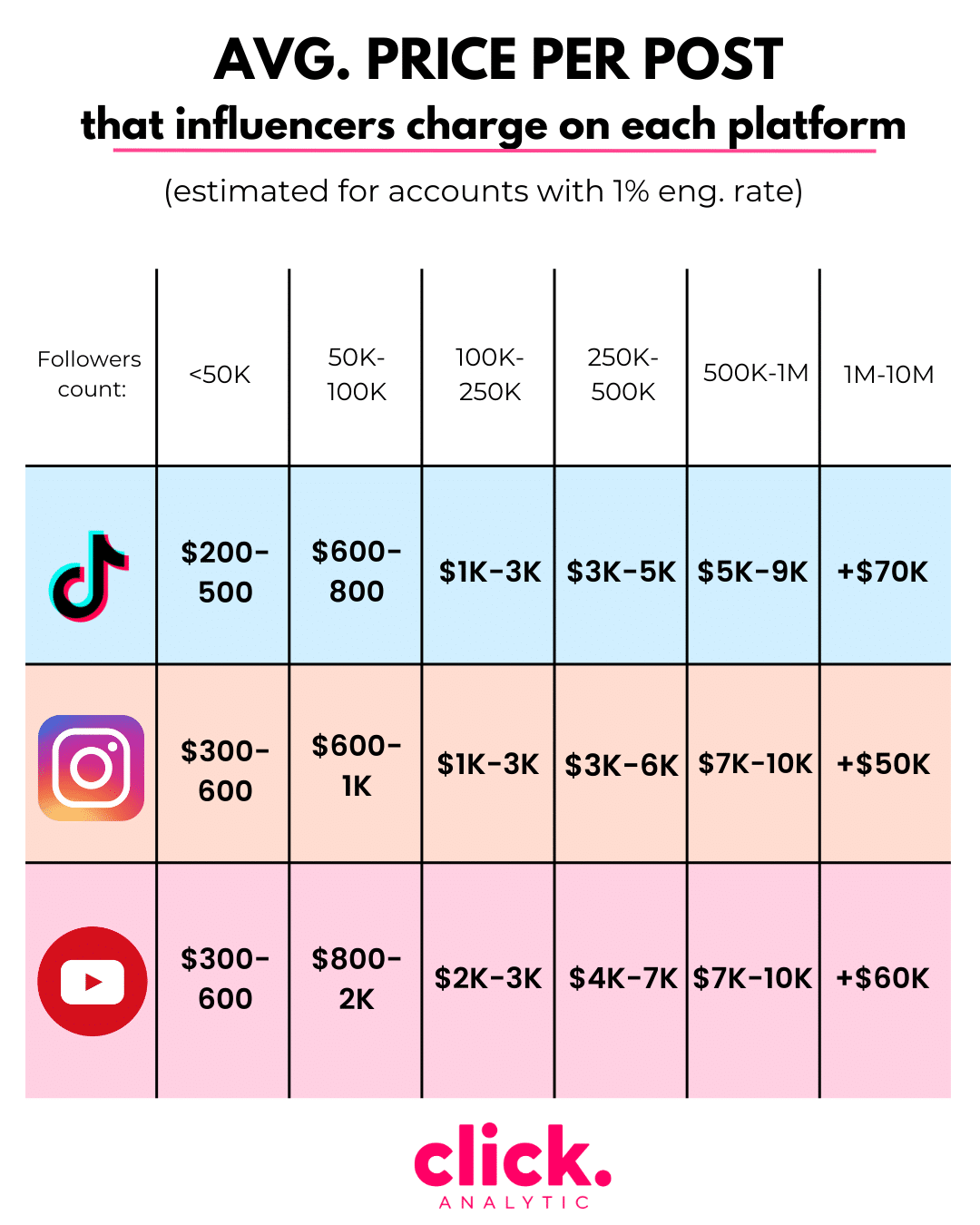
We created this handy chart with the help of Click Analytic, which automatically calculates the average price per piece of content for any Instagram, YouTube, or TikTok account.
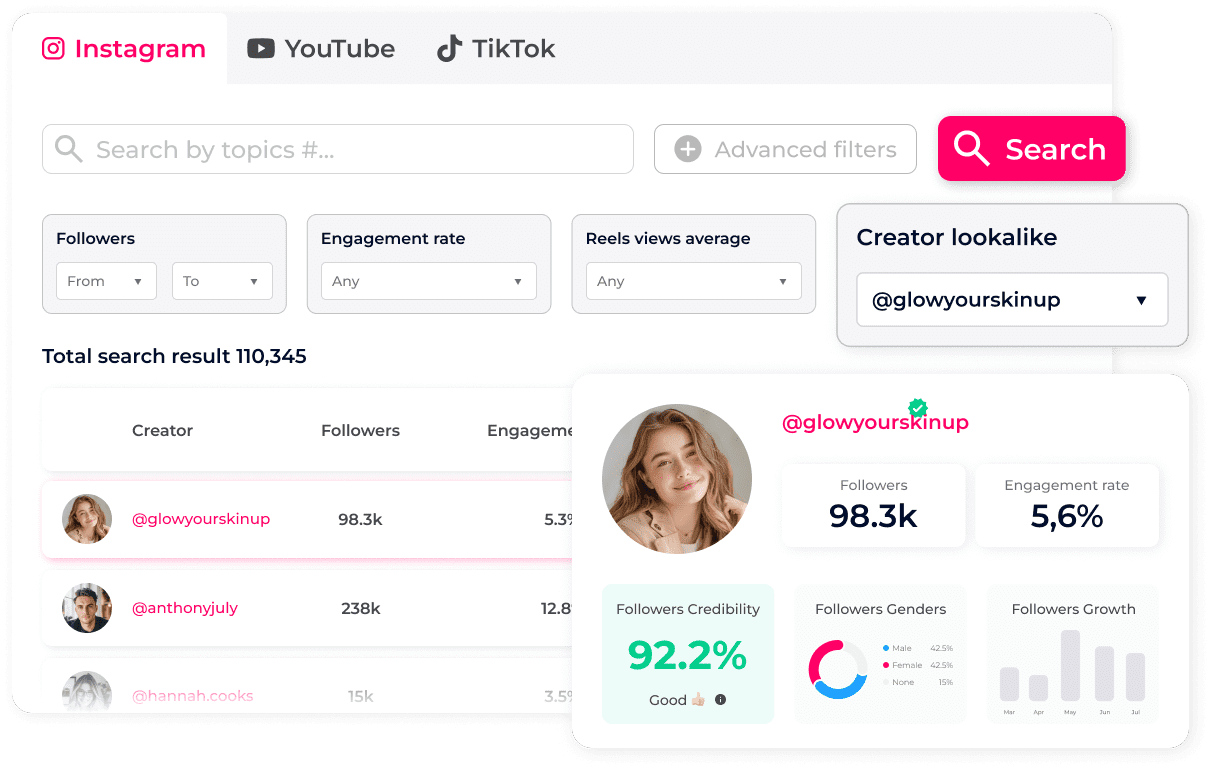
But wait—did you know there’s a “sponsored content 2.0”? Yup, a method called “whitelisting” is quickly gaining traction. Stick with me, and I’ll walk you through it.
💡 Conseil de pro : To make sponsored posts more effective, aim for repetition. The more content you buy from a creator, the lower the cost per piece becomes.
2️⃣ Gifting and Seeding
Influencer gifting is a fantastic way for small brands with limited budgets to harness the influencer marketing benefits of driving sales and boosting visibility.
How does it work? You send influencers your product for free in exchange for content and reviews. This method allows you to tap into influencer marketing benefits without hefty upfront costs.
But what’s the difference between gifting and seeding?
Gifting is a one-time deal. You provide the product for free, and in return, the influencer creates content.
Seeding, on the other hand, is more of a long-term strategy. You send products without expecting anything in return, building relationships over time. If influencers create content, that’s a bonus, but the main goal is to nurture connections for future influencer marketing benefits.
The beauty of gifting and seeding? It’s not just about visibility. You can also gain free user-generated content (UGC), product feedback, and reviews—major influencer marketing benefits.
However, it’s important to remember that influencer gifting is a numbers game. Not every influencer will try or post about your product. The more you send, the better your chances of seeing results. With over 65 million influencers on Instagram alone, the opportunities for influencer marketing benefits are endless.
Of course, to make the most of gifting, it’s crucial to find influencers who are the perfect fit. Use tools like Click Analytic to analyze any profile’s metrics, audience demographics, interests, and more across Instagram, YouTube, or TikTok.
💡 Conseil de pro: Streamline the process by creating a Google form for influencers to request products, and automate your outreach by sending mass emails with the form link.
Easy peasy!
@ling.kt Replying to @Christen Dominique forever grateful 🩷 thank you @Gisou I love you more then ever 🥹🫶🏼 #gisoufridge #gisou ♬ These Words - Badger & Natasha Bedingfield
3️⃣ Affiliate Marketing
Affiliate marketing is a game-changer for turning influencers into sellers for their communities, offering clear pros and cons of influencer marketing.
How does it work? Affiliate marketing is a performance-based partnership where influencers earn a commission for each sale they drive. Brands provide influencers with unique affiliate links or promo codes to share with their audience.
Every time someone makes a purchase using that link or code, the influencer earns a commission—one of the key pros of influencer marketing when done through affiliate models.
One major advantage of affiliate marketing is that it’s much easier to track compared to traditional influencer campaigns. While typical influencer marketing can help measure new followers, reach, and engagement, it’s often difficult to link those metrics directly to sales.
With affiliate marketing, however, brands can directly measure the sales and revenue generated by influencer posts using trackable links or codes. This transparency is a big advantage of influencer marketing when performance is critical.
However, there are also cons of influencer marketing through affiliate programs. Not every influencer’s audience is primed to buy, which can result in fewer conversions despite high engagement.
Additionally, your product needs to be easy to sell, or influencers may lose interest if their audience isn’t buying.
💡 Conseil de pro: To maximize the pros of influencer marketing through affiliate programs, ensure your product is easy to sell and the process is smooth for influencers. Set up a landing page that explains the commission structure, create unique links or codes, and make it simple for creators to join and track their results.
For example, TikTok Shop, launched in 2021, has become a major player by leaning heavily into affiliate programs with creators. Even influencers with as few as 1,000 followers can apply, making it accessible and efficient.
TikTok’s focus on affiliate marketing has paid off, with 64% of users saying they’d buy a product after watching a creator promote it, and 81% discovering new brands through influencer recommendations.
While affiliate marketing offers clear benefits — like trackable results and easy-to-measure ROI—there are also some cons, such as the reliance on an influencer’s ability to convert their audience into buyers.
However, when done right, it can be an extremely effective way to drive sales and boost brand visibility.
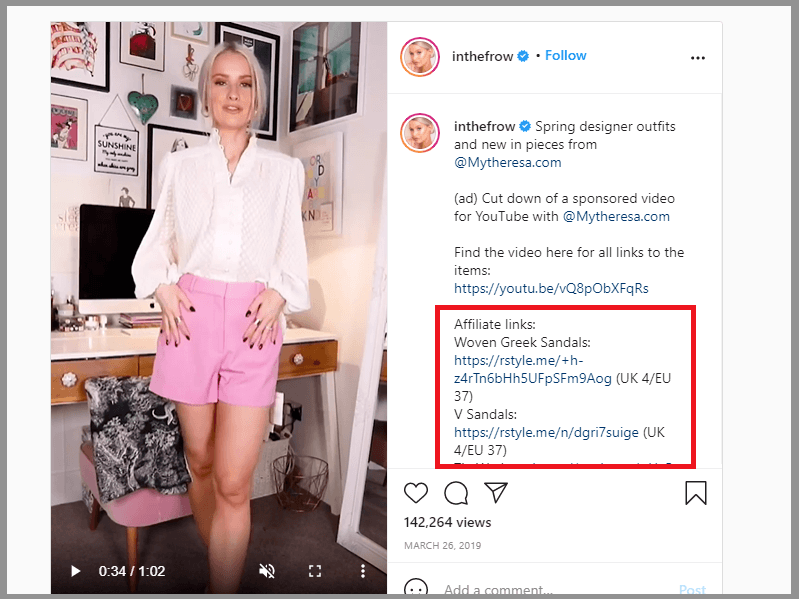
4️⃣ UGC
UGC (User-generated content) is the hot topic of the year, and for good reason.
Why? Well, brands recently realized that instead of only promoting to influencers’ audiences, they could actually buy that content and repurpose it across their own channels.
And boom! This is how UGC exploded onto the scene.
How does it work: There are two main ways:
► Brands acquire the rights to reuse content created by their own customers (organic UGC).
►Or, they buy content directly from UGC creators, without promoting it through influencer accounts (paid UGC).
It’s cheaper, more authentic, and performs better than professional content. Think about it—pro shoots can cost upwards of $10K for just 10-20 photos. But UGC? You can get content for as little as $25 per piece.
No wonder UGC has become the buzzword of 2024—this strategy is powerful. UGC is more genuine than traditional marketing content, and it drives real results.
Just check out these jaw-dropping stats:
-> Conversion rates soar by 144% when online shoppers interact with UGC, like reviews and testimonials.
-> UGC-based ads achieve 4x higher click-through rates (CTR).
-> Ads featuring UGC see 5x higher conversion rates.
-> UGC cuts cost-per-click (CPC) by 50%.
Look at what Zara did:
Zara’s e-commerce visuals used to focus on high-fashion, editorial looks. But by late 2023, the demand for more authentic, user-generated content was impossible to ignore.
So what did they do?
Instead of relying solely on professional photoshoots, Zara started filling its website with UGC!
This switch didn’t just boost sales (by the way, time spent on the site shoots up by 90% with UGC content), it also fostered deeper engagement.
By featuring real customers, Zara built a whole new community, and guess what? People started creating more content because they loved being featured by the brand!
And here’s the best part—you don’t have to sit around waiting for customers to create UGC. There are creators who specialize in producing this type of content for your brand. You can simply pay for content made specifically for repurposing.
Wondering where to find these UGC creators? Check out Click Analytic’s UGC Marketplace, with +1,000 creators ready to collaborate with you! 😉.
One of our clients slashed their CTR by 60% after incorporating UGC into their strategy. I sat down with them for an interview to get the inside scoop— check it out if you want to master UGC too!
First, we tried branded ads. Those performed not good at all.
Then we tried to run UGC campaigns.
At first, we thought something was wrong with the reporting because our cost per install dropped by 60%.
Want to dive deeper into full UGC’s potential? Here’s our ultimate guide!
5️⃣ Whitelisting
Influencer whitelisting is making waves in 2024, and for good reason.
Marketers are raving about it—whitelisting can boost ad conversions by 30% compared to traditional ads and slash customer acquisition costs by 70%!
How does it work: You pay influencers for permission to run ads directly from their accounts.
But why is it so powerful?
Because, as a brand, you’re tapping into an influencer’s follower base, massively extending your reach. In simple terms: when you post from their account, you’re not reaching your own audience—you’re unlocking a whole new group of potential customers.
How’s it different from regular influencer partnerships?
Usually, when we think of influencer marketing, we think of #sponsored posts on personal accounts. The process is straightforward: brands pay creators to produce content and influencer post it on their own account. After that, brands may repurpose that post on their own socials.
Whitelisting, though, takes it to another level.
With whitelisting, brands run ads directly from the influencer’s account, so the ad looks like it’s being posted by the influencer themselves. Brands can tweak these ads a little for better performance—adding “Shop now” buttons, changing up the copy, or even making slight edits to the content.
Want to know how to pick the right influencers for whitelisting? Check out this full guide!
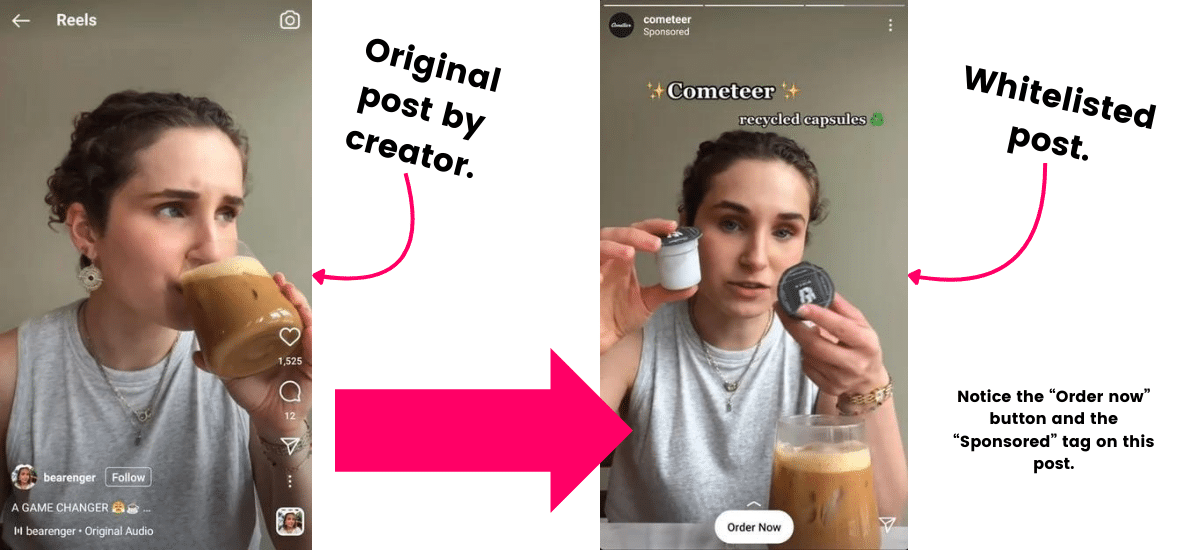
6️⃣ Ambassadorship
Ambassadorships are the ultimate long-term collaboration where influencers become the face of your brand.
It’s a powerful way to build credibility, increase visibility, and drive conversions over time.
How does it work: You sign a long-term contract with an influencer, making them the face of your brand. Unlike short-term campaigns, ambassadorships are all about ongoing partnerships, with influencers deeply aligning with your brand’s values and mission.
One of the biggest perks of using brand ambassadors? The consistency they bring to your messaging.
Because they’re with you for the long haul, ambassadors gain a deeper understanding of your product and values. This makes their endorsements feel more authentic and credible, which can build strong loyalty with your customers.
Even better, ambassadors help you solidify a strong brand identity. Their consistent presence across platforms reinforces your brand’s image in the market, making you more recognizable—and trusted.
💡Pro tip : Long-term partnerships can be more cost-effective because the budget per influencer tends to decrease over time.
Whitelisting, though, takes it to another level.
Here’s a smart idea: co-create a product with your brand ambassadors. Why? Because fans will jump at the chance to get their hands on something their favorite influencer helped create.
It’s not just about boosting sales—it’s about building a deeper connection between your brand, the influencer, and their community.
Plus, rather than paying your ambassador on a monthly basis, you can offer equity in your company. It gives them real skin in the game, meaning they’ll be even more invested in your success.
Another great idea? Get your ambassadors involved in events! Whether it’s a pop-up, a social media takeover, or a webinar, having your ambassadors and influencers at your events can drive engagement and create a buzz.
To make it easier for you, here’s the visual comparison of each partnership type:
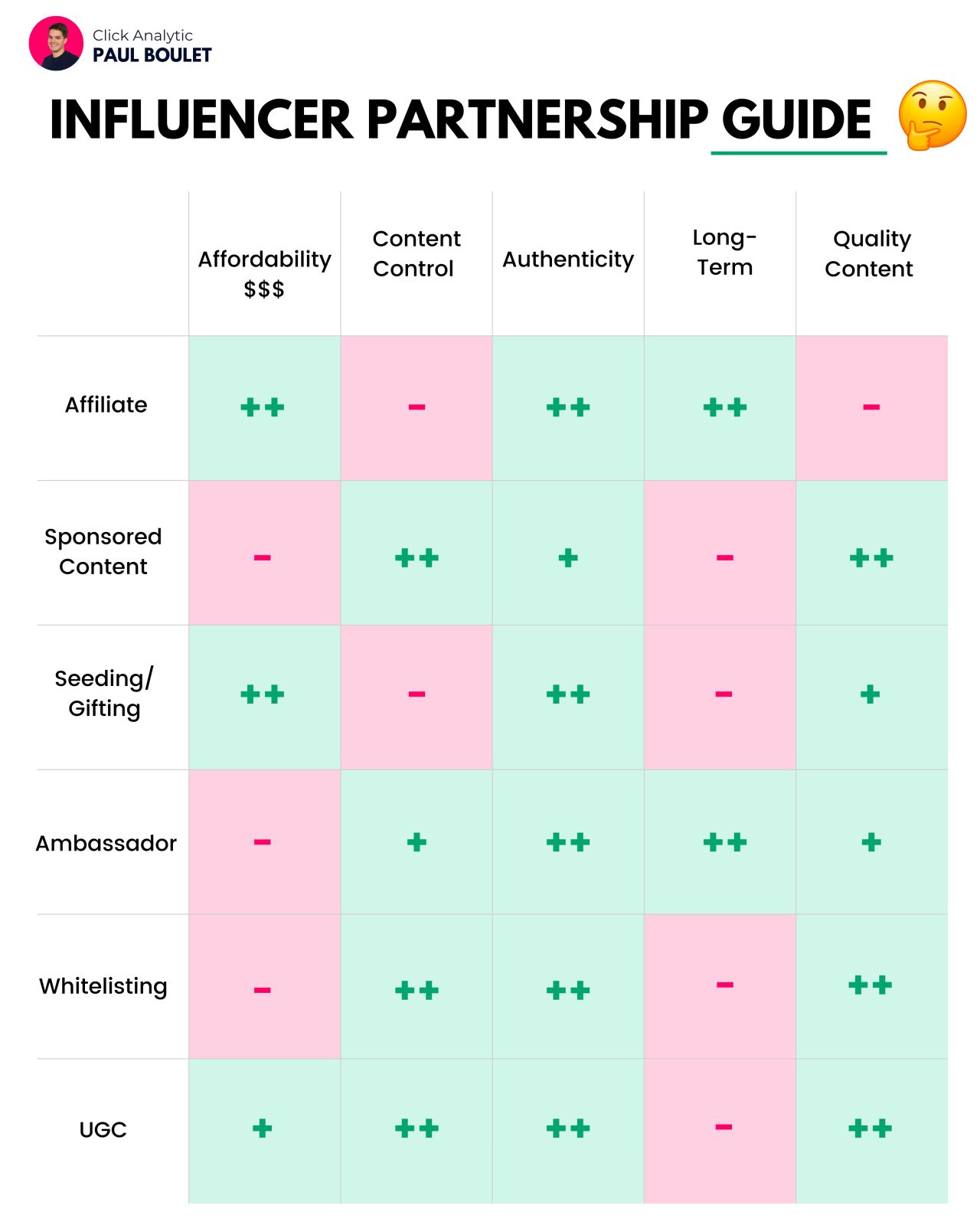
That’s a wrap! Now you’ve got the 101 on influencer marketing.
Now, want to know if your brand can work with creators? Follow me further:
Can Your Business Use Influencer Marketing?
It used to be a common belief that influencer marketing was just for DTC brands. But here’s the truth: businesses of all kinds can tap into the power of this strategy.
Check out how different industries are making the most of influencer marketing:
📌 Beauty and Cosmetics
Beauty influencers are a game-changer, delivering makeup tutorials, product reviews, and demonstrations that show customers exactly how products perform on real people.
In fact, the majority of beauty brands collaborate with beauty influencers for product launches, reviews, and tutorials.
📌 Fashion and Apparel
Fashion influencers bring outfits to life, showcasing styles and accessories in relatable settings.
Brands like Nike, Adidas, and Fashion Nova leverage these influencers to help consumers visualize how their products fit into everyday or athletic lifestyles.
📌 Health and Fitness
In the fitness world, influencers share workout routines, diet tips, and reviews of gear that resonate with their audience.
Companies like Gymshark, Lululemon, and Nike partner with fitness influencers to showcase how their products support healthy, active lifestyles. Talk about a win-win!
📌 Food and Beverage
Food bloggers and influencers are crucial for reviewing restaurants, products, and recipes, creating a genuine connection with foodies.
Brands like HelloFresh, Pepsi, and Starbucks use influencers to engage with culinary enthusiasts through tempting reviews and fun recipes.
📌 Travel and Hospitality
Travel influencers bring destination reviews, travel tips, and experiences to the table, capturing the hearts of adventure-seekers.
Airlines like Emirates and hotel chains like Marriott collaborate with travel influencers to highlight stunning locations and unique experiences.
📌 Technology and Gadgets
Tech influencers are all about those hands-on gadget reviews. They help buyers make informed decisions by showcasing features and performance.
Companies like Apple, Samsung, and GoPro partner with tech influencers to launch their newest innovations and products.
📌 Gaming Industry
Gaming influencers are masters at creating engaging content. They review games, host live streams, and craft gaming content that speaks directly to their audience.
Brands like Razer, PlayStation, and Epic Games work with gamers on platforms like Twitch and YouTube to connect with highly engaged gaming communities.
📌 Education and Online Courses
Influencers focused on personal development, business, and academic content recommend online courses or educational tools that align with their audience’s interests.
Companies like Udemy, MasterClass, and Skillshare work with influencers who provide tutorials and promote their learning platforms.
Recently, we’ve also seen the rise of B2B influencers.
These experts are shaping opinions in specific industries, and interestingly, 75% of B2B businesses are already leveraging this trend.
Virtually any business — whether it’s a global brand or a small startup — can benefit from influencer marketing as long as they collaborate with influencers whose audience matches their target demographic.
Now that you have the theoretical knowledge, it’s time to put it into practice!
But how do you build an influencer marketing strategy? How much budget should you allocate?
Don’t worry, we’re here to help you out.
Book a strategy call with Click Analytic.
We’ll analyze your business from top to bottom and develop a strategy that will boost your sales — all for free!
Yup, you heard that right. 😊
Book a call now!
Conclusion
As user behavior and shopping habits evolve, it’s clear that fresh ideas and innovative promotion techniques are a must.
And here influencers enter—the perfect solution to your marketing woes.
Influencer marketing isn’t just a trend; it’s a dynamic channel that opens up endless possibilities for promoting your brand, no matter your budget or goals.
With influencers becoming the new media powerhouses, they bring a massive amount of trust and authenticity to the table.
Sure, like any strategy, influencer marketing has its challenges. But with the right approach and understanding of the industry, you can easily navigate those bumps in the road.
So, gear up to harness the power of influencer marketing and drive real results that elevate your brand!
Q/A on Influencer marketing
How do I choose the right influencer for my brand?
Choosing the right influencer is all about alignment—your brand’s vibe needs to match their audience’s interests and values.
First, look at their engagement: are their followers genuinely interacting with their content, or are they just scrolling by?
Next, check their content style—is it in line with how you want your brand represented?
And finally, look at their audience demographics. Do they match your target market?
Des outils comme Click Analytic, plateforme de recherche d'influenceurs make it easy to filter through millions of influencers to find your perfect match in minutes, instead of hours of scrolling on your own.
Also, check out our free rankings around best influencers based on location and niches
Why are brands seeking ongoing partnerships with influencers rather than one-off projects?
It’s simple—ongoing partnerships drive better results.
Think about it, long-term collaborations build consistency and trust. When consumers see an influencer talk about your brand more than once, it feels authentic, not just a “one-time promo” they’re getting paid for.
Next, check their content style—is it in line with how you want your brand represented?
It’s also more cost-effective, with the potential to negotiate better rates over time. Plus, ambassadors get to know your brand deeply, so their content feels more genuine.
In the end, long-term deals = stronger credibility + better ROI.
What’s the difference between working with micro, macro, and celebrity influencers?
It’s all about the numbers and impact.
Micro-influenceurs have smaller followings (usually 10K to 100K) but often higher engagement rates because they have a loyal, niche community. They’re great for targeted campaigns and driving conversions.
Les macro-influenceurs (100K to 1M followers) offer bigger reach, but their audience might be more general. They’re solid for brand awareness.
Célébrités (1M+ followers) bring massive visibility, but with a hefty price tag and sometimes lower engagement rates. It all depends on your campaign goals—awareness vs. engagement vs. conversions.
How can I track the success of an influencer marketing campaign?
To know which metrics to track, first answer this question: what is my campaign goal? Is it conversions and sales? Increasing visibility? Boosting awareness?
Tracking success with influencers is totally possible, thanks to tools like UTM links, promo codes, and affiliate programs. Each click, sale, and conversion can be tied back to the specific influencer or campaign, so you know what’s working in real time.
Also, track engagement metrics like likes, comments, shares, and story views—these will give you a sense of how the audience is responding.
And remember, influencer marketing is all about tweaking—don’t hesitate to adjust the campaign if the numbers aren’t adding up.
How is TikTok’s role in influencer marketing evolving?
TikTok has completely flipped the script. It’s not just about viral dances or trending challenges anymore—brands are now all-in, and influencers are at the heart of it.
TikTok’s algorithm is unbeatable for organic reach, and influencers know exactly how to create content that hits that sweet spot.
The platform’s authenticity is what Gen Z and millennials are all about. But here’s where it gets even more interesting: TikTok Shop.
Now, influencers can help brands sell products directly on the platform, blending entertainment with seamless shopping experiences. This means consumers can discover, engage, and purchase—all without leaving the app.
It’s a huge win for brands looking to drive real-time sales and conversions while keeping things fun and interactive. TikTok is quickly becoming the hub for influencer-driven commerce, and if you’re not on it yet, you’re missing out.
Is influencer marketing suitable for small businesses, or do you need a big budget?
You absolutely don’t need a huge budget to leverage influencer marketing.
Micro-influencers, in particular, are often affordable and offer better engagement with niche audiences.
They work well for small businesses because they’re more authentic, have closer relationships with their followers, and often charge less than macro-influencers or celebrities.
Plus, many influencers are open to product exchanges, especially if they love your brand. Influencer marketing can be tailored to fit your budget, no matter how big or small.
What should I include in an influencer brief?
Your influencer brief needs to cover the essentials, but leave room for creativity—that’s what influencers are great at!
First, define the campaign goals (Are you building awareness? Driving conversions?).
Be clear about your brand’s tone, style, and must-have messaging. Include details like deadlines, content formats, and whether the influencer needs to use certain hashtags, links, or disclosure requirements.
Finally, lay out the “do’s and don’ts”—this helps avoid any messaging mishaps. But don’t over-direct. The best influencer content feels natural, not forced.
To learn more about the perfect influencer brief, check out this guide
What legal aspects should I consider when working with influencers?
Don’t sleep on the legal stuff. Influencers are required to disclose sponsored content, and failing to meet these standards can cause real headaches.
Make sure to include ad disclosures like #ad ou #sponsorisé, and check your country’s regulations (for example, the ASA in the UK or the FTC in the US).
Also, make sure your contract includes content usage rights—will you be able to repurpose their content on your website or other platforms?
Cover these bases before any campaign launches to avoid unnecessary drama.
How can influencer marketing benefit B2B brands?
B2B brands can totally get in on the influencer game.
Instead of beauty influencers or travel bloggers, you’re looking for industry experts, thought leaders, and niche professionals who influence decisions within your field.
B2B influencers help boost credibility and trust in saturated markets by positioning your brand as a leader.
They also help businesses gain visibility at key industry events or in front of highly targeted audiences.
Don’t underestimate the power of a well-placed recommendation from someone respected in your industry!
What are the conversations around pay transparency in influencer marketing?
Pay transparency is a hot, yet still evolving topic right now.
Creators are pushing for more standardization and visibility around rates.
Influencers want to know what others in their niche or with similar follower counts are getting paid, and brands are being called to offer fair compensation.
Some influencers are now openly sharing their rates to hold brands accountable and prevent underpayment.
It’s becoming clear: fair pay = better relationships = better content.
Brands need to ensure they’re compensating influencers fairly to maintain strong, long-lasting partnerships.
